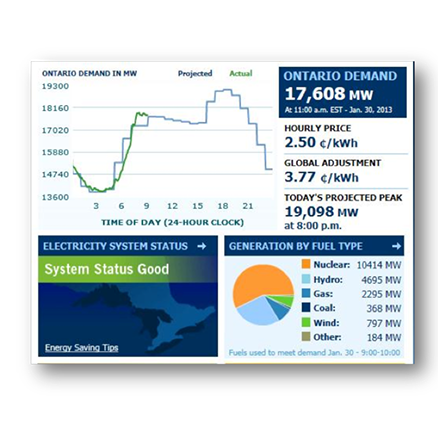905.685.7481 Contact



In closing, we hope that you at the very least have a better, more educated and clearer understanding of the whole premise behind arriving at wholesale electricity pricing. Again, remember that we are not discussing the entire price on your bill yet, just the real price of electricity as indicated on your utility bill. To explain your bill in more detail we would have to get into the intricacies of Time-of-Use pricing and the Ontario Energy Board regulations.
UNDERSTANDING ELECTRICITY: The Pricing Complexities of Electricity in Ontario
There is a great deal of misunderstanding and confusion as it relates electricity pricing in Ontario and how that price affects your business. Therefore, it appears we need to establish a clear understanding of the facts in order to gain a better understanding of how this relates to your business.
Our goal here is to simply explain the basics of electricity pricing. To be very clear though, we are only going to focus on the mechanism that sets the price of electricity on your bill, and therefore we will ignore the delivery charge, the regulatory charge, and the debt retirement charge, as these fees are added on top of the price of electricity, and no matter if you are a large corporation with significant consumption, a medium business with moderate consumption, or a small business with relatively low consumption, all electricity users pay these fees, which are clearly defined on your utility bill.
Hourly Ontario Energy Price (HOEP)
A key factor to arriving at electricity prices is called the Hourly Ontario Energy Price, or HOEP (pronounced “hope”), and this price is set on the open market, which works like this:
The Independent Electricity System Operator (IESO) is responsible to predict the demand for electricity for each hour. In theory, using this information, generators (i.e.: natural gas plants, nuclear power plants or wind farms) will competitively bid in order to supply electricity in order to meet the predicted demand. As well in theory, the least expensive electricity suppliers would ideally get contracts first. Of course as demand rises price rises, and the more expensive generating plants would then need to enter the market.
Important to note, all the generating plants playing in this market have prices that are fixed, guaranteed, and/or subsidized… so they will never lose money no matter how low the market price goes. On that note, let’s look at the below graph of the monthly weighted average HOEP from 2005 to 2012 to see how this pricing structure works:
The key point here, outside of Ontario’s older and larger hydro-electric producing facilities, no generator of electricity can afford to sell power at 4¢/kWh. So, how are the above historical prices possible? Great question, and the answer is in the Global Adjustment factor.
Global Adjustment
This magical concept is done utilizing an innovative strategy called the Global Adjustment (GA). This is an additional hourly fee charged to electricity users to pay for all those fixed prices, guarantees and subsidies, should the HOEP price goes too low. Therefore, let’s plot the Global Adjustment on the same graph and review the results below:
Remember that the Global Adjustment is designed as the “price guarantor” for generators of electricity. The GA actually went into the negative in late 2005 due to the fact the HOEP was generating a far better price from the market than the guarantee, and so this meant Ontario Power Generation’s nuclear and large hydro plants were getting a higher price than the guarantee, thus they had to kick back money. However, for most of the 2005 to 2009 period, the market HOEP was high enough to satisfy the pricing needs of the generators of electricity. It’s also interesting to note on this graph that during that period when the HOEP hit 6¢/kWh, the Global Adjustment then went to zero.
So what is the real price of electricity?
In order to arrive at the real or actual price of electricity, we have to add the HOEP and the Global Adjustment together to get your true price of electricity, less all the fees indicated at the start of this explanation of electricity prices in Ontario. To illustrate what this looks like from a visual perspective, the graph below plots all 3 on the same graph:
Confusion Reigns Supreme
The fact of the matter is that the HOEP is not the real market price, because you have to add in the Global Adjustment, and this is the reason for many of the misunderstandings and confusion in the media and with other groups, individuals and the like. Of course with so much misleading information out there, it’s understandable due to the way information has been presented. Take for example the following screenshot of the IESO.
The red line is the real, true and/or actual price for electricity on the open market from 2005-2012. The graph will also identify how the price spiked to almost 8¢/kWh during the exciting days of 2005, before eventually falling back to a 5¢ to 6¢/kWh range from 2006-2007. The price had gradually increased up until the 2005 peak was exceeded, and then the price broke through 8¢/kWh in late 2012.
The IESO is very informative on a number of key levels, as we can clearly see the current price level of the global adjustment, just below the hourly price on the right hand side of the image. Of course the HOEP is showing as the “Hourly Price”, thus why there can be confusion, as there is absolutely no attempt here to add the HOEP to the Global Adjustment price to show the real price of electricity. Therefore, this example would have the public believe that the market price of electricity was actually only 2.5¢/kWh, rather than indicating the correct combined price of 6.27¢/kWh. Can you see why all the misconceptions here? And this is just one example of the complexities of electricity pricing in Ontario.
As indicated on the graph, the highest HOEP was back in 2005 where it reached 10¢/kWh. After this the market leveled off with prices between 4¢ and 6¢/kWh over the next few years. When the economy struggled in 2009 electricity demand fell and the price dropped even further, which then fluctuated between 2¢ and 4¢/kWh over the next 4 years.
Interestingly enough, and as the above graph indicates, the Global Adjustment displays pretty much an opposite pattern to the HOEP price pattern, with one interesting exception to note, when it went into the negative. The GA for 2005 to 2009 mainly varied between zero and 1¢/kWh, but when the HOEP price crashed then the GA jumped up to a range of about 4¢/kWh, and it subsequently crept higher over time. At this point I’m sure you are wondering what’s going on here?


Learn Today
Electricity
About Us
What We Do
Energy
Follow Us
The Value of Objective Advice
Volumes
Mission
Vision
Core Values
Energy Advice
Industries We Serve
Government
Business
Municipality
Educational
Hospitals
Hospitality & Commercial
Manufacturing
Industrial
Processing
Natural Gas
Electricity
Explosion of Communication
© Copyright 2015 Provincial Energy Inc.
Provincial Energy Canada Corporation, 20 Amber Street #16, Markham, ON L3R 5P4


















